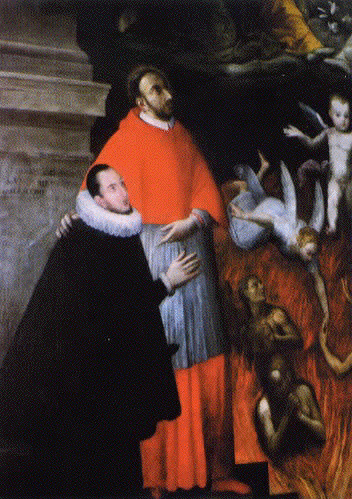 This painting, "Il perdono di Gesualdo" by Giovanni
Balducci, which shows a Last Judgement scene, was commissioned by Carlo
Gesualdo for a small chapel he had built called Santa Maria delle Grazie.
The composer is shown kneeling (in black), accompanied by his newly canonised
uncle, Carlo Borromeo, who is interceding on his behalf. Two nude figures,
male and female, in the lower right-hand corner, engulfed in the flames
of purgatory or hell, are thought to be Gesualdo's unfaithful wife and her
lover; the child near the top of the picture is possibly his first wife's
second child and the issue of that illicit relationship.
This painting, "Il perdono di Gesualdo" by Giovanni
Balducci, which shows a Last Judgement scene, was commissioned by Carlo
Gesualdo for a small chapel he had built called Santa Maria delle Grazie.
The composer is shown kneeling (in black), accompanied by his newly canonised
uncle, Carlo Borromeo, who is interceding on his behalf. Two nude figures,
male and female, in the lower right-hand corner, engulfed in the flames
of purgatory or hell, are thought to be Gesualdo's unfaithful wife and her
lover; the child near the top of the picture is possibly his first wife's
second child and the issue of that illicit relationship.
St Carlo Borromeo (1538-1584), nephew of Pope Pius IV,
archbishop of Milan, canonised in 1610, was an influential person in Gesualdo's
spiritual life. It is thought that Borromeo's support for the flagellation
confraternities encouraged Gesualdo's involvement in this form of penitential
practise. One report, published 20 years after his death, describes the
composer's miserable last years suffering from neurotic guilt and fear of
damnation, when he was "afflicted by a vast horde of demons which gave
him no peace for mnay days on end unless ten or twelve young men, whom he
kept for the purpose, were to beat him violently three times a day, during
which operation he was wont to smile joyfully. And in this state did he
die miserably at Gesualdo, but not until he had lived to witness...the death
of his only son Don Emmanuele, who hated his father and had longed for his
death..."
The life and music of Gesualdo are the subject of a Werner
Herzog film, Death For Five Voices.
Suggested Reading - Glenn Watkins, Gesualdo, The Man
And His Music (Clarendon Press, Oxford, 1991); Denis Arnold, Gesualdo
(BBC Music Guides, 1984)
Text © Rubberneck; Photo ©
Symphonia
back to main text
millennial home
 This painting, "Il perdono di Gesualdo" by Giovanni
Balducci, which shows a Last Judgement scene, was commissioned by Carlo
Gesualdo for a small chapel he had built called Santa Maria delle Grazie.
The composer is shown kneeling (in black), accompanied by his newly canonised
uncle, Carlo Borromeo, who is interceding on his behalf. Two nude figures,
male and female, in the lower right-hand corner, engulfed in the flames
of purgatory or hell, are thought to be Gesualdo's unfaithful wife and her
lover; the child near the top of the picture is possibly his first wife's
second child and the issue of that illicit relationship.
This painting, "Il perdono di Gesualdo" by Giovanni
Balducci, which shows a Last Judgement scene, was commissioned by Carlo
Gesualdo for a small chapel he had built called Santa Maria delle Grazie.
The composer is shown kneeling (in black), accompanied by his newly canonised
uncle, Carlo Borromeo, who is interceding on his behalf. Two nude figures,
male and female, in the lower right-hand corner, engulfed in the flames
of purgatory or hell, are thought to be Gesualdo's unfaithful wife and her
lover; the child near the top of the picture is possibly his first wife's
second child and the issue of that illicit relationship.